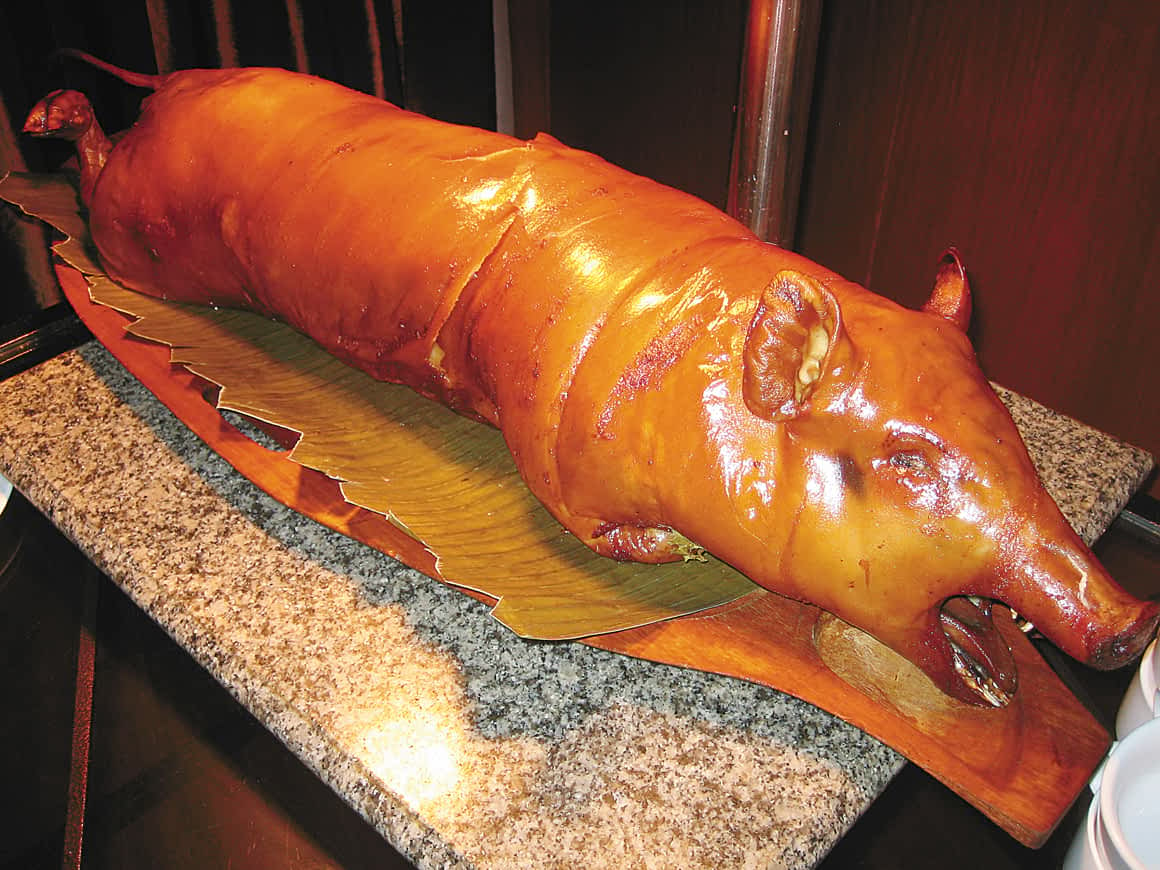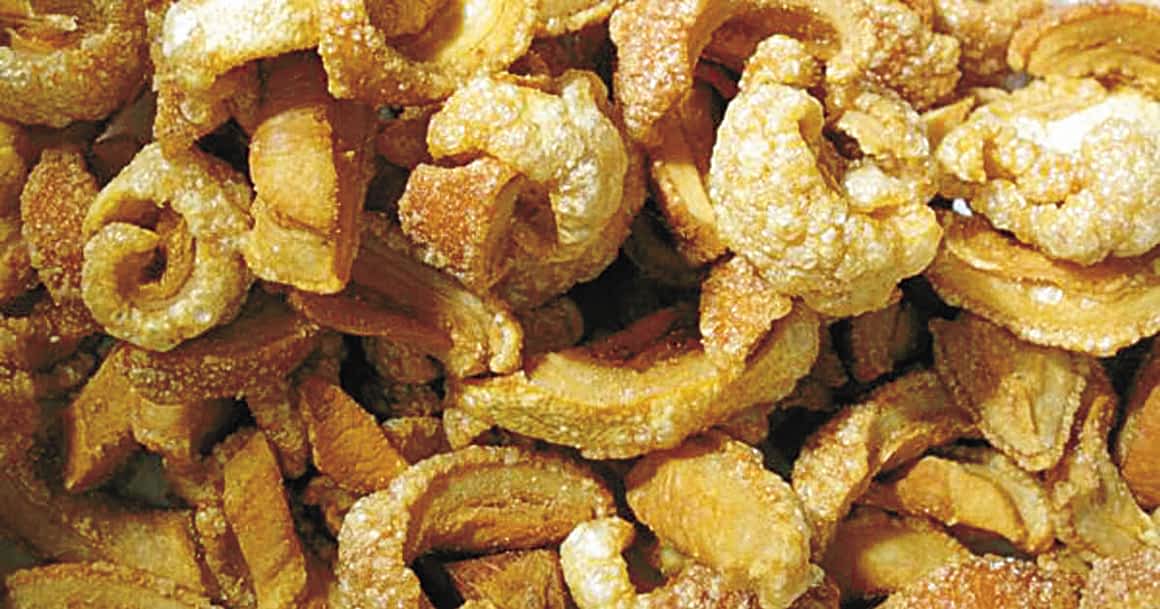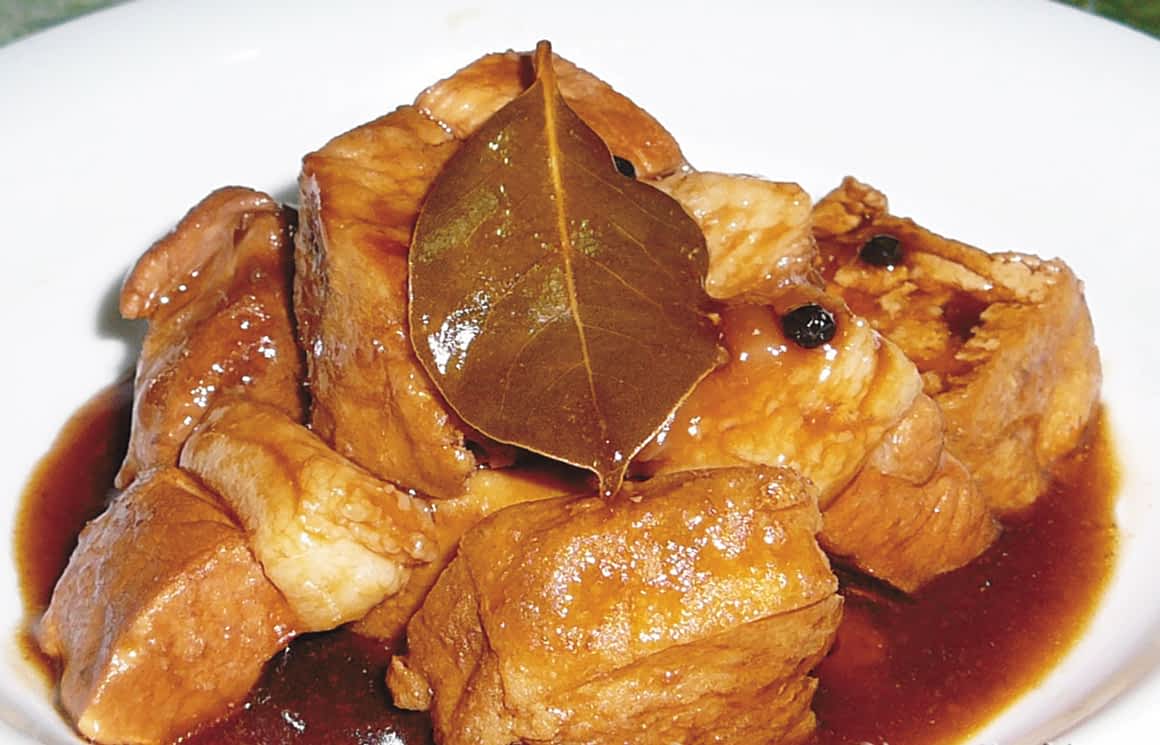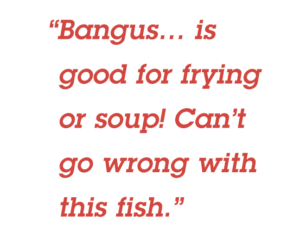Adobo & More: Adobo Nation
Sharon Zalsos
 Can you relate? If you are a Filipino meeting a non-Filipino person for the first time and the subject of your ethnicity comes up, isn’t it almost always followed by “So you know how to cook adobo?” or “I just love adobo.” Most Filipinos are familiar with adobo. When someone describes their adobo experience to us, it’s almost always pork. Can you name another adobo dish? Again, there’s pork adobo, chicken, squid, fish can be adobo’d (now the word just became a verb), goat, I’m sure frog legs in some places, I’ve seen boiled eggs adobo, etc.… Adobo recipes vary from province to province. The basic ingredients have to be present though: soy sauce, vinegar, garlic, peppercorns. Others will add bay leaves, ginger and other secret ingredients to spice up their adobo. Speaking of spices, you can also add a little kick to your dish with just a dash of chili sauce. But don’t overdo it, it’s not meant to be hot. But as good as these dishes sound and as much recado or ingredients there are to be adobo’d, the Philippines has more to offer in the culinary world besides adobo.
Can you relate? If you are a Filipino meeting a non-Filipino person for the first time and the subject of your ethnicity comes up, isn’t it almost always followed by “So you know how to cook adobo?” or “I just love adobo.” Most Filipinos are familiar with adobo. When someone describes their adobo experience to us, it’s almost always pork. Can you name another adobo dish? Again, there’s pork adobo, chicken, squid, fish can be adobo’d (now the word just became a verb), goat, I’m sure frog legs in some places, I’ve seen boiled eggs adobo, etc.… Adobo recipes vary from province to province. The basic ingredients have to be present though: soy sauce, vinegar, garlic, peppercorns. Others will add bay leaves, ginger and other secret ingredients to spice up their adobo. Speaking of spices, you can also add a little kick to your dish with just a dash of chili sauce. But don’t overdo it, it’s not meant to be hot. But as good as these dishes sound and as much recado or ingredients there are to be adobo’d, the Philippines has more to offer in the culinary world besides adobo.
Filipino cooking is beyond adobo.

Photo courtesy pepes-kitchen.co.uk

Photo courtesy www.businessnews.com.ph
Have you ever heard of the pork lechon? This is the slowly rotisserie-cooked whole pig over a very open hot fire. Not to be mixed up with kalua pork or imu pig which is buried under a pile of banana leaves and covered with dirt for a smoky, steamy cook. Lechon is a perfectly medium to dark brown shine in color and if you have a chance to try this dish, a bite of the skin is a must! Many will rave that so and so sells the best lechon over the others. But from my past experience, the best lechon is when you bite into the skin and it gives you the beautiful, soft crunch that is like eating a juicy chicharon! Not the kind of crunch that’s hard to bite into or chewy. It has to be light with each bite you take and flavor drips from your lips. Personally, my mom’s hometown houses the best kept secret when it comes to lechon. A long stretch of lechon dealers can be found close to Timoga which is just past Linamon, about 20 minutes out of Iligan City. Yes, all the way south to Mindanao.

Photo courtesy panlasangpinoyrecipes.com
Another dish that Filipinos are known for is Crispy Pata. This is the hind legs of the pork. This meaty and fattier part of the pork is deep fried and served whole. The pork itself is cooked or boiled with seasoning prior to deep frying. But similar to the lechon, the outside of this dish should also be crunchy. The meat inside on the other hands needs to be soft and juicy. If the inside is dry, it’s a no go for me. On Maui, I finally found an eatery who serves this! Joey’s Kitchen in Nāpili. If you have never tried this dish and you like pork, this is a must. The drive will be worth it. I personally like it with a side of the traditional dipping sauce which is composed of white vinegar, crushed garlic, one sili and a little bit of salt and pepper. If you know of another place that serves crispy pata share on Fil-Am Voice’s Facebook page. For a non-pork eater, I sure know my pork dishes!
Now, experiencing culinary experience in the Philippines is venturing out beyond the pork dishes. Let’s talk about the sopas or soups. One of my favorite Pinoy soups is sinigang, which has a tangy, green tamarind base, clear soup. Others substitute kamias or iba to get the sour taste but the true authentic sinigang taste for me has to be tamarind or sampaloc in Tagalog. Growing up, my mom used to cook sinigang na baboy for us, translated to pork sinigang. My version of this is beef sinigang. I’m happy to see a few restaurants serve this beef dish. If you are not a fan of the sour in your soup, simply take the tamarind away and replace with ginger. Now you have beef sabao or beef soup. Sabao is soup in Tagalog. For non-red meat eaters, you can replace the beef with chicken, add papaya to this soup base and “voila!” you have chicken papaya also known as chicken tinola.

Photo courtesy philippinesfoodrecipes.wordpress.com
Now, since the Philippines is made up of over 7,100-plus islands—give or take depending on the tide—seafood is bountiful in the Philippines. Fish dishes are mouthwatering everywhere. Whether you walk around the open market or the food court of any shopping malls in Manila, you will find a plethora of seafood displays. Perfectly broiled, whole squid a little larger in size than your Samsung S9+. Also available are sugpo or prawns the size of a 5-oz. bottle of Tabasco sauce. Clams, oysters, mussels are plentiful and prepared in soups, fried, grilled, or steamed. My favorite will always be piniritong isda or fried fish. Descale the fish, wash, season with sea salt and pepper and deep fry for me please. Add a scoop of newly cooked white rice and a dipping sauce of toyo (soy sauce) with a squeeze of calamansi and I’m a happy camper for sure. Depending on the weather, mood or occasion of course dictates how your fish is prepared. Soup base I mentioned earlier with sinigang or tinola can be incorporated with fish as the main ingredient. Of course, the best way to cook fish depends on the variety of fish.  The famous bangus (bang-ooos) or milk fish is good for frying or soup! Can’t go wrong with this fish. Although I highly recommend the already deboned version. I love the frozen version in the local grocers but I also look forward to a fresh dish on my next trip to the Philippines. Another favorite of mine is pink snapper or the snapper family. Locally known as Opakapaka. White, delicate, perfect for steaming. Add chopped ginger, garlic, red onion salt, pepper and lemon grass in the belly of the fish and steam away. Be sure to keep a close eye, you don’t want to overcook. When you’re ready to serve, place the whole fish in a big plate and pour hot peanut oil with already lightly toasted chopped garlic over the fish.
The famous bangus (bang-ooos) or milk fish is good for frying or soup! Can’t go wrong with this fish. Although I highly recommend the already deboned version. I love the frozen version in the local grocers but I also look forward to a fresh dish on my next trip to the Philippines. Another favorite of mine is pink snapper or the snapper family. Locally known as Opakapaka. White, delicate, perfect for steaming. Add chopped ginger, garlic, red onion salt, pepper and lemon grass in the belly of the fish and steam away. Be sure to keep a close eye, you don’t want to overcook. When you’re ready to serve, place the whole fish in a big plate and pour hot peanut oil with already lightly toasted chopped garlic over the fish.
Now, after being presented with these different cuisine varieties and you are still fixed on adobo… you are a true fan. Have you made a comparison to every adobo that you have tasted over the years? I was born and raised in the city of Makati in Metro Manila. The taste I’ve acquired for adobo is different when I visit relatives in Mindanao. When our family moved to Hawai‘i in the early ’90s, I was introduced to several other versions of adobo recipes mostly from the Ilocos regions. On Maui alone, you will find unique flavors of adobo from each individual restaurant or caterer. Have you tasted Tante’s award-winning adobo? It’s not made from pork. And he incorporated an ingredient that is quite unusual for an adobo dish. The ingredient he features with his adobo certainly brings out the richness and bold taste of the soy sauce and vinegar reduced. I won’t spoil it for those of you who have yet to experience the flavors of Tante’s award winning adobo. It’s off menu of course, served only on special occasions. Of course, everyone’s mom or dad makes the best adobo, right? If you are truly confident in your adobo, enter your cooking in this year’s “Any Kine Adobo” contest at the annual celebration of the Maui Fil-Am Heritage Festival. This year, the event will be on Saturday, October 20, 2018 from 10 a.m. to 3 p.m. The winner of the contest will take home a cash prize and your name will be etched on the plaque to join past champions of the Any Kine Adobo Contest. Whether it be pork, chicken or squid adobo, enjoy your dish and keep discovering new things to adobo!
Sharon Zalsos is a past president of the Maui Filipino Chamber of Commerce (three terms) and has her own marketing business: Kalona International LLC. She’s also an ACN Independent Business Owner. A former Miss Maui Filipina, Sharon played the lead in MAPA’s presentation of Miss Saigon. A graduate of Maui High School, Sharon is employed with the County of Maui and a proud Veteran of the United States Air Force.
